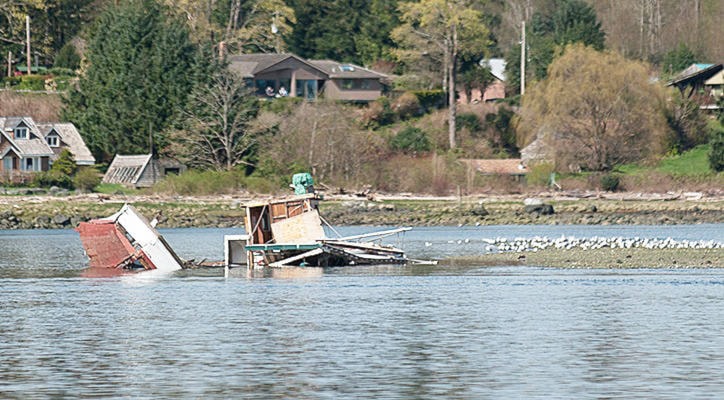One of many items of discussion at this weekend’s Association of Vancouver Island and Coastal Communities (AVICC) conference surrounded the long-standing issue of abandoned vessels along our coast.
It’s an issue that has been discussed at nearly every annual conference for 15 years, according to presenter Sheila Malcolmson, MP for Nanaimo-Ladysmith.
“Who here has got abandoned vessels in their harbour right now?” Malcolmson asked to open the session Saturday afternoon. Well over half the people in the at-capacity room raised their hands.
Malcolmson, along with Ladysmith mayor Aaron Stone, Chief John Elliott from the Stz’uminus First Nation and Rod Smith, director of the Ladysmith Maritime Society went on to recount the story of the Viki Lynn II, a 33-metre vessel that was abandoned near Dunsmuir Islands sometime before 2012 then towed to Ladysmith’s harbour by Transport Canada. It remained there until October of last year, despite continued pleas to the federal government for it to be removed before it could leak its 33,000 litres of oil and solvents into the harbour.
Campbell River has seen this problem itself, though not to that scale.
In 2015, a 50-foot converted live-aboard ran aground in the estuary and was left to disintegrate but was eventually taken away thanks to private funding. And just last year, the Tyee Club found a 40-foot sailboat on the bottom of the estuary during their annual cleanup.
The overarching message of the session was that it is currently far too difficult and costly for municipalities to remove derelict boats, and no community should have to go through the rigmarole that Ladysmith had to in order to get a dangerous vessel out of their waters, so there needs to be coordination between levels of government – municipal, provincial and federal – to come up with a solution. More than anything, though, there needs to be one body that takes this problem under its mandate.
Malcolmson suggests that body should be the Coast Guard.
If the Coast Guard was properly funded so they could be responsible for derelict boats, it would remove one of the major issues that crops up every time there’s an abandoned vessel in the water somewhere: the argument over whose responsibility it is to deal with it, Malcolmson says.
“It’s a jurisdictional quagmire,” Stone says, adding the effort and cost required for municipalities trying to deal with this issue – which he agrees should really be a federal matter – takes valuable resources away from the work councils should actually be doing.
“Since 2007, we’ve had 24 resolutions from our council – those aren’t procedural resolutions, those are resolutions that resulted in either staff work or work of council to try and resolve the issue,” Stone says. “Out of those, there were at least a half-dozen staff reports that required a significant amount of research and time from many levels of staff, and we all know what kind of cost in terms of both lost productivity and real tax dollars coming out of our community that we’re spending putting high-value resources to work to solve this issue. It’s taking away from the core priorities that we have as a council. We’ve got infrastructure defecit, we’ve got asset management work we need to do, and we also want to make our community better, improve our local economy and broaden our tax base. Those are the important things we need to be working on, not fighting with other levels of government to try and bring people together to solve this in the absence of comprehensive legislation.”
Smith told the story of contacting the Coast Guard to inquire about what was being done about the Vicky Lynn II, “and I was told, ‘we don’t have any money, but if it goes down, we can access a $9-billion fund.’”
However, Smith says, there’s also a federal fund currently sitting at somewhere around $408-million, “which grows by about $5.9-million per year and costs about $1.5-million to administer. It’s there for the removal of a vessel that’s polluting the waters or has the potential to pollute the waters. Last year, do you know how much they spent getting rid of derelict vessels (using that fund)? $27,000.”
Malcolmson says she has hope there will be a federal solution as part of the recently-announced $1.5-billion Oceans Protection Plan, but the release of specifics of what that plan contains have been delayed, likely until the fall.
“We might still see something, but it’s much slower than I thought it would be.”
So she has a piece of legislation that she is ready to put forward should the feds fail to incorporate derelict vessel removal into their plan. It entails not only giving the Coast Guard the resources they need to take care of abandoned vessels, but also a boat amnesty plan for owners who want to give up their watercraft, an improved vessel registration plan with associated fees that would go into a fund to help clean up abandoned boats and a push to work with salvage companies and markets to create an economy based around recycling boats that have outlived their useful lives.
Malcolmson closed out the session by encouraging those in the room to share her campaign encouraging the federal government to take jusrisdiction over abandoned vessels and create a national strategy to deal with the problem, a link to which can be found within this story at campbellrivermirror.com
